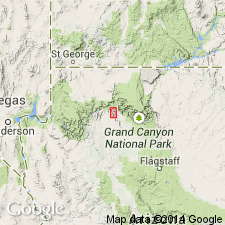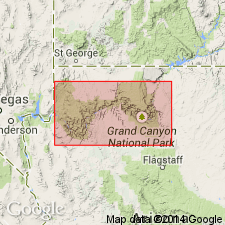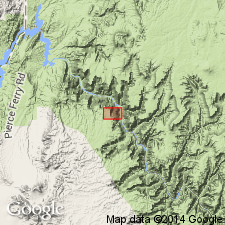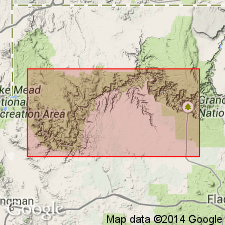
- Usage in publication:
-
- Watahomigi Formation*
- Modifications:
-
- Named
- Dominant lithology:
-
- Sandstone
- Limestone
- Mudstone
- Conglomerate
- Siltstone
- AAPG geologic province:
-
- Plateau sedimentary province
Summary:
Named as oldest formation of Supai Group (rank raised) for Watahomigi Point, west side of Havasu Canyon about 1 1/2 mi northwest of Supai village, Coconino Co, AZ in Plateau sedimentary province where type measured. Consists of limestone and mudstone in equal proportions. Mostly conglomeratic near base, massive limestone in middle, and conglomeratic at top. The sandstone is red brown and very fine grained. Interbedded siltstone is pale red to gray and may be muddy, very limy, flat bedded to laminated; some beds have jasper lenses. Interbedded mudstone is pale red to red purple, and may be silty calcareous, wavy to flat bedded or laminated. Conglomerate is gray, pale red to red brown; it has limestone pebbles in a red-brown mudstone matrix, and some jasper lenses. Limestone is very light gray, gray red to yellow gray, fine grained to silty with abundant concretions and some jasper lenses. Forms a ledgy slope that retreats away from Redwall. Is 215 ft thick at type. Nomenclature table. Overlies unconformably the Horseshoe Shale Member of Redwall Limestone. Underlies Manakacha Formation (new); contact is an erosion surface. Of Morrowan and early Atokan, or Early and Middle Pennsylvanian age.
Source: GNU records (USGS DDS-6; Denver GNULEX).

- Usage in publication:
-
- Watahomigi Formation*
- Modifications:
-
- Revised
- AAPG geologic province:
-
- Plateau sedimentary province
Summary:
Rocks formerly included in the Callville Limestone in the extreme western part of the Grand Canyon are assigned to the lower part of the Supai Group (Watahomigi Formation). Age is Early Pennsylvanian.
Source: GNU records (USGS DDS-6; Menlo GNULEX).

- Usage in publication:
-
- Watahomigi Formation*
- Modifications:
-
- Revised
- AAPG geologic province:
-
- Plateau sedimentary province
Summary:
New name Surprise Canyon Formation applied to rocks previously assigned to the Redwall Limestone and to Watahomigi Formation in Grand Canyon area, AZ in Plateau sedimentary province. Surprise Canyon is lithologically distinct from both the Redwall and the Watahomigi. Contact with the Redwall is unconformable and is placed at base of a cobble and pebble conglomerate above the limestone. Contact with Watahomigi is unconformable and is placed at the top of a thin, gray, ledge-forming limestone. Of middle Morrowan to Atokan age. Cross sections.
Source: GNU records (USGS DDS-6; Denver GNULEX).

- Usage in publication:
-
- Watahomigi Formation*
- Modifications:
-
- Age modified
- Biostratigraphic dating
- AAPG geologic province:
-
- Plateau sedimentary province
Summary:
Is basal formation of the Supai Group. Overlies Surprise Canyon Formation in report area. Conodonts of the upper Chesterian (Upper Mississippian) ADETOGNATHUS UNICORNIS Zone were recovered from marine limestones of the Surprise Canyon Formation in western and central Grand Canyon, Mohave and Coconino Cos, AZ (Plateau sedimentary province). Basal limestones of the overlying Watahomigi Formation contain conodonts of the slightly younger RHACHISTOGNATHUS MURICATUS/ADETOGNATHUS LAUTUS Zone, which indicate either a latest Chesterian or an earliest Pennsylvanian age. Recovery of the Pennsylvanian species DECLINOGNATHODUS NODULIFERUS seventeen meters above the base of the Watahomigi in Quartermaster Canyon suggests that the Mississippian-Pennsylvanian boundary occurs within the lower units of the Watahomigi Formation of the Supai Group. Toward the end of the Chesterian, Surprise Canyon sediments began to accumulate in deep erosional channels cut into the underlying Redwall Limestone. Surprise Canyon deposition ceased during a brief period toward the end of the latest Mississippian. This hiatus probably corresponds to the eustatic fall in sea level during the latest Mississippian observed by many other workers. Deposition of the Watahomigi appears to have commenced [at least locally] before the end of the Mississippian when the channels were almost, but not completely filled.
Source: GNU records (USGS DDS-6; Denver GNULEX).
For more information, please contact Nancy Stamm, Geologic Names Committee Secretary.
Asterisk (*) indicates published by U.S. Geological Survey authors.
"No current usage" (†) implies that a name has been abandoned or has fallen into disuse. Former usage and, if known, replacement name given in parentheses ( ).
Slash (/) indicates name conflicts with nomenclatural guidelines (CSN, 1933; ACSN, 1961, 1970; NACSN, 1983, 2005, 2021). May be explained within brackets ([ ]).

